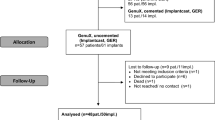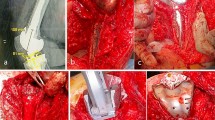Abstract
Purpose
The study aims to analyze long-term clinical and radiographic results, and survival of re-revision total knee arthroplasty (TKA) using fully cemented stems performed on femurs with diaphyseal deformation.
Methods
Thirty-seven re-revision TKAs using fully cemented stems performed in femoral diaphyseal deformations, characterized as diaphyseal canal enlargement and cortex deformation due to aseptic loosening of previously implanted stems, between 2003 and 2015 were retrospectively reviewed. The mean follow-up period was 10.0 years. Clinically, Western Ontario and McMaster Universities Osteoarthritis Index (WOMAC) and range of motion (ROM) were evaluated. Radiographically, mechanical axis (MA) and component positions were measured. Complications and survival rates were also analyzed.
Results
Clinically, the WOMAC significantly improved at final follow-up (61.2 vs 47.2, p < 0.001), but not the ROM (95.5 vs 102.5, p = 0.206). Radiographically, the MA and component positions were appropriate, with no changes in component positions from immediately post-operative to final follow-up, but with MA change from varus 2.9° to 3.7° (p = 0.020). Two cases (5.4%) with history of previous infections developed periprosthetic joint infection (PJI). Debridement with polyethylene insert exchange following antibiotic suppression were performed in those cases because of concern for difficult implant-cement removal. The five and ten year survival rates were 100% and 93.2%, respectively.
Conclusion
Fully cemented stems are viable in providing long-term satisfactory survival after re-revision TKA in patients with femoral diaphyseal deformation. However, it should be used carefully for those with previous infections.



Similar content being viewed by others
References
Song SJ, Kim KI, Bae DK, Park CH (2020) Mid-term lifetime survivals of octogenarians following primary and revision total knee arthroplasties were satisfactory: a retrospective single center study in contemporary period. Knee Surg Relat Res 32:50
Tan AC (2021) The use of cement in revision total knee arthroplasty. J Orthop 23:97–99
Pasquier GJM, Huten D, Common H, Migaud H, Putman S (2020) Extraction of total knee arthroplasty intramedullary stem extensions. Orthop Traumatol Surg Res 106:S135–S147
Spinello P, Thiele RAR, Zepeda K, Giori N, Indelli PF (2022) The use of tantalum cones and diaphyseal-engaging stems in tibial component revision: a consecutive series. Knee Surg Relat Res 34:12
Sheridan GA, Garbuz DS, Masri BA (2021) Hybrid stems are superior to cemented stems in revision total knee arthroplasty: a systematic review and meta-analysis of recent comparative studies. Eur J Orthop Surg Traumatol 31:131–141
Wang C, Pfitzner T, von Roth P, Mayr HO, Sostheim M, Hube R (2016) Fixation of stem in revision of total knee arthroplasty: cemented versus cementless-a meta-analysis. Knee Surg Sports Traumatol Arthrosc 24:3200–3211
Lee SH, Shih HN, Chang CH, Lu TW, Chang YH, Lin YC (2020) Influence of extension stem length and diameter on clinical and radiographic outcomes of revision total knee arthroplasty. Bmc Musculoskelet Disord 21:15
Engh GA, Ammeen DJ (1999) Bone loss with revision total knee arthroplasty: defect classification and alternatives for reconstruction. Instr Course Lect 48:167–175
Giesinger JM, Hamilton DF, Jost B, Behrend H, Giesinger K (2015) WOMAC, EQ-5D and Knee Society score thresholds for treatment success after total knee arthroplasty. J Arthroplasty 30:2154–2158
Reddy NVR, Saini MK, Reddy PJ, Thakur AS, Reddy CD (2022) Analysis of clinical and radiological outcomes of long tibial stemmed total knee arthroplasty in knee osteoarthritis complicated by tibial stress fracture. Knee Surg Relat Res 34:7
Song SJ, Lee HW, Kim KI, Park CH (2021) Appropriate determination of the surgical transepicondylar axis can be achieved following distal femur resection in navigation-assisted total knee arthroplasty. Knee Surg Relat Res 33:41
Fleischman AN, Azboy I, Fuery M, Restrepo C, Shao H, Parvizi J (2017) Effect of stem size and fixation method on mechanical failure after revision total knee arthroplasty. J Arthroplasty 32(202–208):e201
Bae DK, Song SJ, Heo DB, Lee SH, Song WJ (2013) Long-term survival rate of implants and modes of failure after revision total knee arthroplasty by a single surgeon. J Arthroplasty 28:1130–1134
Song SJ, Lee HW, Park CH (2020) A current prosthesis with a 1-mm thickness increment for polyethylene insert could result in fewer adjustments of posterior tibial slope in cruciate-retaining total knee arthroplasty. J Arthroplasty 35:3172–3179
Song SJ, Kang SG, Park CH, Bae DK (2018) Comparison of clinical results and risk of patellar injury between attune and PFC sigma knee systems. Knee Surg Relat Res 30:334–340
Healy WL, Della Valle CJ, Iorio R, Berend KR, Cushner FD, Dalury DF, Lonner JH (2013) Complications of total knee arthroplasty: standardized list and definitions of the Knee Society. Clin Orthop Relat Res 471:215–220
Clement ND, Bardgett M, Weir D, Holland J, Gerrand C, Deehan DJ (2018) What is the minimum clinically important difference for the WOMAC index after TKA? Clin Orthop Relat Res 476:2005–2014
Patel AR, Barlow B, Ranawat AS (2015) Stem length in revision total knee arthroplasty. Curr Rev Musculoskelet Med 8:407–412
Matar HE, Bloch BV, James PJ (2021) High survivorship of short-cemented femoral stems in condylar revision total knee arthroplasty without significant metaphyseal bone loss: minimum 5-year follow-up. J Arthroplasty 36:3543–3550
Meijer MF, Reininga IH, Boerboom AL, Stevens M, Bulstra SK (2013) Poorer survival after a primary implant during revision total knee arthroplasty. Int Orthop 37:415–419
Webb JC, Spencer RF (2007) The role of polymethylmethacrylate bone cement in modern orthopaedic surgery. J Bone Joint Surg Br 89:851–857
Dayan I, Moses MJ, Rathod P, Deshmukh A, Marwin S, Dayan AJ (2020) No difference in failure rates or clinical outcomes between non-stemmed constrained condylar prostheses and posterior-stabilized prostheses for primary total knee arthroplasty. Knee Surg Sports Traumatol Arthrosc 28:2942–2947
Author information
Authors and Affiliations
Contributions
The following authors have made substantial contributions to the followings: (1) the conception and design of the study (S. J. S., C. H. P.), provision of study materials or patients (D. K. B.), acquisition of data (H. W. L., C. H. P.), analysis and interpretation of data (S. J. S., H. W. L., and C. H. P.), (2) drafting the article (S. J. S., H. W. L., D. K. B., and C. H. P.), (3) revision of the article (S. J. S., H. W. L., D. K. B., and C. H. P.), and (3) final approval of the version to be submitted (S. J. S., H. W. L., D. K. B., and C. H. P.).
Corresponding author
Ethics declarations
Ethics approval
This study was performed in line with the principles of the Declaration of Helsinki. Approval was granted by Institutional Review Board of Kyung Hee University Medical Center.
Consent to participate
Informed consent was obtained from all individual participants included in the study.
Consent for publication
There is no any individual person’s data in any form.
Competing interests
The authors declare no competing interests.
Additional information
Publisher's note
Springer Nature remains neutral with regard to jurisdictional claims in published maps and institutional affiliations.
Level of evidence: IV
Rights and permissions
About this article
Cite this article
Song, S.J., Le, H.W., Bae, D.K. et al. Long-term survival of fully cemented stem in re-revision total knee arthroplasty performed on femur with diaphyseal deformation due to implant loosening. International Orthopaedics (SICOT) 46, 1521–1527 (2022). https://doi.org/10.1007/s00264-022-05412-2
Received:
Accepted:
Published:
Issue Date:
DOI: https://doi.org/10.1007/s00264-022-05412-2




